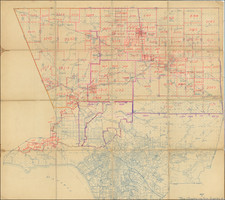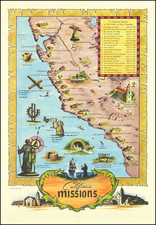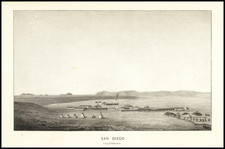Fine map of Carlsbad, with a second map of North Carlsbad on the verso, showing the progress of development in the town following the arrival of the South Coast Land Co.
This is the earliest map of Carlsbad we have seen, capturing the real birth of the City in the 1920s, subsequent to the original attempt to develop the town in the 1880s and 1890s failed and Carlsbad nearly became a ghost town.
The map shows the earliest development and subdvisions of Carlsbad, with the Town of Carlsbad, Thum Lands, Palisades, and other features clearly delineated. Several early annotations in red and black pencil show contemporary use of the map by an early owner.
On the verso is a second map entitled: Map of North Carlsbad Showing Holdings of South Coast Land Co . . . /gallery/enlarge/47981jca
This is the first time we have ever seen this map. We have located a later blue line copy of the map, but never an original.
Carlsbad History
The first European land exploration of Alta California, the Spanish Portolà expedition of 1769, met native villagers while camped on Buena Vista Creek. During the Mexican period, in 1842, the southern portion of Carlsbad, was granted as Rancho Agua Hedionda to Juan María Marrón.
In the 1880s, a former sailor named John Frazier dug a well in the area. He began offering his water at the train station and soon the whistle-stop became known as Frazier's Station. A test done on a second fresh-water well discovered the water to be chemically similar to that found in some of the most renowned spas in the world, and the town was named after the famed Spa in the Bohemian town of Karlsbad in Czech Republic.
To take advantage of the find, the Carlsbad Land and Mineral Water Company was formed by a German-born merchant from the Midwest named Gerhard Schutte together with Samuel Church Smith, D. D. Wadsworth and Henry Nelson. The naming of the town followed soon after, along with a major marketing campaign to attract visitors. The area experienced a period of growth, with homes and businesses sprouting up in the 1880s. Agricultural development of citrus fruits, avocados and olives soon changed the landscape. In 1887, the first train depot was constructed in Carlsbad.
In 1887, one year after the formation of the Carlsbad Land and Water Company, the population of Carlsbad was 300. The Company invested $50,000 to build the Carlsbad Hotel, which was destroyed by fire shortly after it opened in 1896. By the time it burned, Carlsbad had practically ceased and several company founders such as Samuel Church Smith had moved to more profitable locations such as San Diego.
The 1890's decade was one of terrible drought. The population in Carlsbad dropped to 155. Over time, most of the city was abandoned and had only six registered voters. The outlying ranches with the Bordon, Kelly and Marron families kept the area populated. The Schutte Family remained in town as one of the original Land Company families. Gerhard Schutte stayed in Carlsbad until 1906, when he moved to National City with his wife Bertha.
While the Carlsbad Land and Water Company was forming in the current northwest quadrant of the city, a similar enterprise was occurring in the coastal area just south of the Rancho Agua Hedionda borders. In 1886, Thomas E. Metcalf, one of the La Costa town and Land Company founders, along with his brother Alfred and Jacob Gruendike, purchased land from Oliver H. Bordon, father of W. W. Bordon who published and edited the Plain Truth Newspaper. O. H. Borden, who settled in the Batiquitos area in 1874, sold all 550 acres of land in "his upper and lower places" as reported in the Plain Truth, to the La Costa Land Company for $18 to $20 an acre. Additionally, The La Costa Land and Town Company purchased 160 acres at $25 an acre from J. C. Peterson. The total 710 acres for the proposed town included land from the present day La Costa Resort to the Pacific Ocean and on both sides of the Batiquitos Lagoon. But this endeavor along the coast was doomed to failure. The land lacked an adequate water supply. The coastal area around Batiquitos Lagoon, while never part of any Rancho Land Grant or developed town, was destined to remain a rather sparsely populated area until development of the La Costa Resort in the 1960s.
Robert Kelly died in 1890 willing his property, the Rancho Agua Hedionda land grant directly east of the fledgling town of Carlsbad, to his brother Matthew's nine children. Between the years 1892 and 1896 the entire land grant was held in common, except for a section in the northwest section sold in 1893 to a Mr. Thorpe. Shortly after the property was sold, Mr. Thorpe resold the land to the Thum Brothers, who held the patent on the Tanglefoot Fly Paper. The land became known as Thum Lands.
The South Coast Land Company In Carlsbad
Gerhard Schutte sold his home on Carlsbad Boulevard to the South Coast Land Company in 1906, and they immediately began using it as housing for their company employees.
In 1913, the South Coast Land Company signed an agreement that guaranteed water delivery from the San Luis Rey Valley to Carlsbad, within one year. The water would run in pipes across the Buena Vista lagoon. By 1914, the South Coast Land Company had purchased all the remaining Carlsbad Land and Water Company land and drilled six water wells in the San Luis Rey valley.
Running the lines to Carlsbad infused the town with new life. With an adequate source of water there was no stopping the influx of people, particularly farmers. The first avocado grove begun by Sam Thompson in 1916 was followed by many more. Avocado Groves spawned an entirely new industry for Carlsbad.
In 1922, the avocado growers began an annual Avocado Day festival downtown to introduce the public to the many ways one could prepare the fruit. By 1928 Carlsbad promoted itself as the Home of the Avocado, with 7000 people attending Avocado Day celebrations. The South Coast Land Company took advantage of this opportunity and began selling five-acre lots of "avocado" land. In addition to the avocado groves that dotted the landscape, flower fields and subtropical fruits were introduced to the area.










![Rand McNally Standard Map of California [2 sheets]](https://storage.googleapis.com/raremaps/img/small/84794.jpg)
![[ Southern California Tourism ] Hunting and Fishing in Southern California on the Santa Fe](https://storage.googleapis.com/raremaps/img/small/101613.jpg)
![[The 5 Californias] Carte de la Californie Suivant 1. La Carte manuscrite de l'Amerique de Mathieu Neron Pecci olen dressee a Florence en 1604, 2. Sanson 1656 . . .](https://storage.googleapis.com/raremaps/img/small/97983.jpg)

